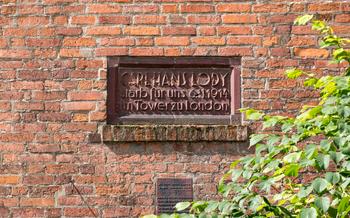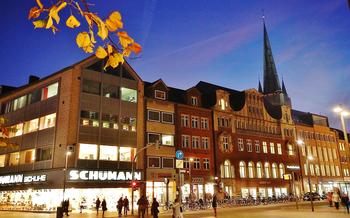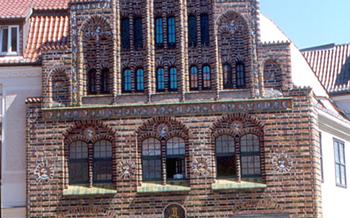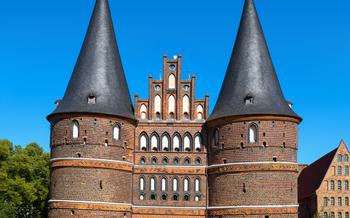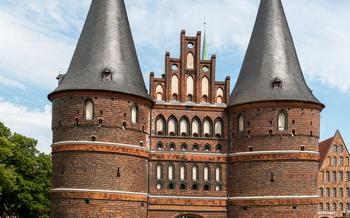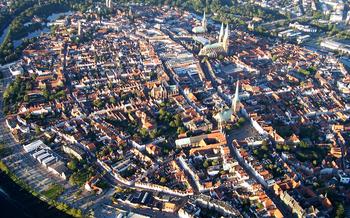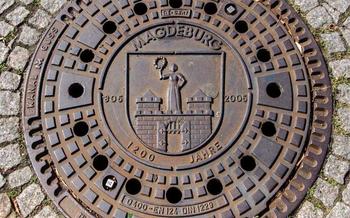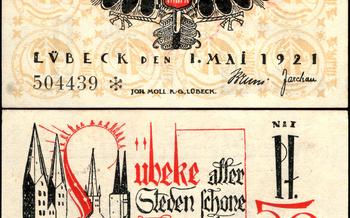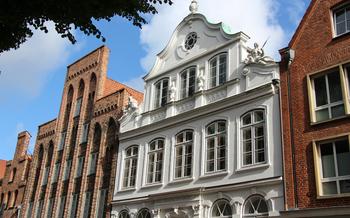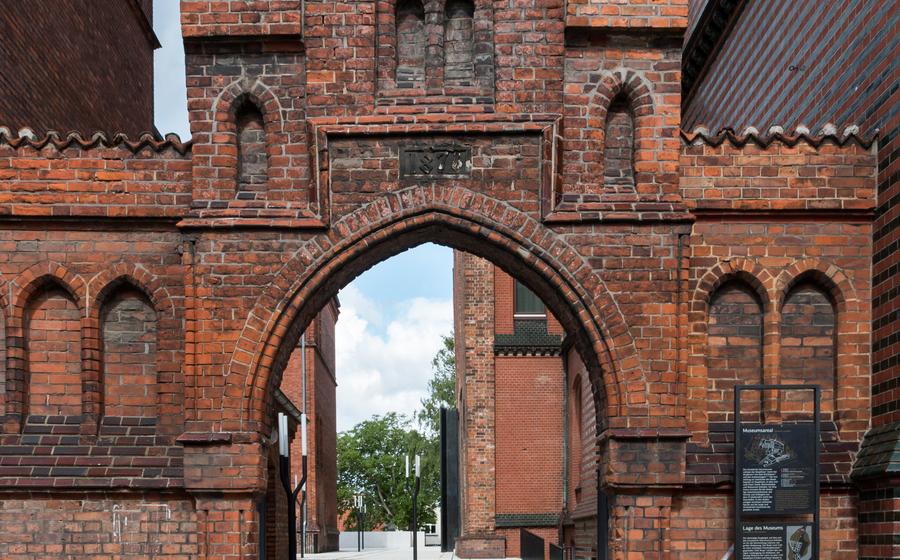
Europäisches Hansemuseum (European Hanseatic Museum)
- Historical Significance of the Hanseatic League
- Museum's Architectural Design and Unique Location
- Interactive Exhibits and Multimedia Presentations
- Thematic Sections and Chronological Journey
- Lübeck's Maritime Legacy
- The Hanseatic Merchants: Economic Powerhouses
- Lübeck's Architectural Treasures
- Trading Routes and Commodities
- Life in a Hanseatic City
- Hanseatic Innovations and Legacy
- The Hanseatic League's Decline
- The Europäisches Hansemuseum's Collections
- The Museum's Educational Programs
- Hanseatic Food and Cuisine
- Exploring Lübeck Beyond the Museum
- Getting to the Europäisches Hansemuseum
- Insider Tip: Explore the Museum's Rooftop Terrace
Historical Significance of the Hanseatic League
The Europäisches Hansemuseum in Lübeck is a captivating journey into the rich history of the Hanseatic League, a powerful alliance of merchant cities that dominated trade in Northern Europe from the 12th to the 17th century. The Hanseatic League played a pivotal role in shaping the political, economic, and cultural landscape of the Baltic Sea region, leaving an enduring legacy that can still be seen today.
Museum's Architectural Design and Unique Location
Housed in a striking contemporary building, the Europäisches Hansemuseum boasts an innovative architectural design that complements Lübeck's historic cityscape. Its prime location on the banks of the River Trave, an important waterway during the Hanseatic era, creates a captivating backdrop for exploring the museum's exhibits.
Interactive Exhibits and Multimedia Presentations
The Europäisches Hansemuseum employs a variety of interactive exhibits and multimedia presentations to bring the Hanseatic era to life. Visitors can engage with touchscreens, listen to audio guides, and watch captivating films that immerse them in the world of Hanseatic merchants, sailors, and everyday life.
Thematic Sections and Chronological Journey
The museum's exhibits are organized into thematic sections that guide visitors on a chronological journey through Hanseatic history. From the league's humble beginnings as a loose association of trading towns to its rise as a dominant force in Northern European trade, the museum provides a comprehensive overview of this fascinating period.
Lübeck's Maritime Legacy
Lübeck's strategic location on the Baltic Sea played a pivotal role in its emergence as a major Hanseatic city. The city's proximity to the sea provided access to vital trade routes, facilitating the import and export of goods, and enabling Lübeck to become a hub for maritime commerce. The city's harbor, with its deep waters and sheltered location, served as a safe haven for ships, contributing to Lübeck's reputation as a reliable and prosperous trading center.
The impact of maritime trade on Lübeck's economy and culture was profound. The city's wealth and prosperity were largely derived from its maritime activities, leading to the accumulation of vast fortunes by Hanseatic merchants. The influx of goods from around Europe and beyond brought new ideas, influences, and cultural exchanges to Lübeck, contributing to the city's cosmopolitan atmosphere and vibrant cultural scene.
To this day, Lübeck's maritime heritage is carefully preserved and celebrated. The city's museums, such as the Europäisches Hansemuseum, showcase the rich history of Hanseatic maritime trade, while the city's annual Hanseatic Days festival brings together people from all over the world to celebrate the city's maritime traditions and cultural legacy.
The Hanseatic Merchants: Economic Powerhouses
The Hanseatic merchants, driven by their entrepreneurial spirit and organizational skills, established an extensive trading network that spanned across Europe and beyond. Their economic prowess was founded upon the control of key trade routes, particularly the Baltic Sea, which granted them a monopoly over the region's commerce. This strategic advantage allowed them to amass immense wealth and influence, shaping the economic landscape of Northern Europe for centuries.
The Hanseatic merchants' monopoly extended from essential commodities like grain, timber, and fish to luxury goods such as spices, silks, and furs. By dominating these trade routes, they became the gatekeepers of commerce, regulating prices, setting standards, and ensuring the smooth flow of goods throughout the region. Their influence and wealth extended beyond economic realms, as they played a pivotal role in politics, diplomacy, and cultural exchange, cementing their legacy as one of the most significant economic forces in medieval Europe.
The Hanseatic merchants' success was not limited to their mercantile pursuits; they also played a crucial role in urban development. As their wealth grew, they invested in the expansion and beautification of their cities, constructing magnificent town halls, churches, and guildhalls. Their patronage of the arts and sciences further contributed to the cultural and intellectual flourishing of the Hanseatic cities, leaving a lasting legacy that continues to shape the identity and heritage of the region to this day.
Lübeck's Architectural Treasures
The Europäisches Hansemuseum stands as a testament to Lübeck's architectural heritage as a Hanseatic city. The museum's building itself, a former Gothic warehouse, showcases the city's distinctive brick architecture, a symbol of Hanseatic wealth and power. In 1987, Lübeck earned the prestigious designation of a UNESCO World Heritage Site, recognizing its exceptional collection of Gothic brick buildings and the significant role it played in the Hanseatic League.
Among Lübeck's architectural highlights is the Holstentor, a magnificent city gate built in the 15th century. Its twin towers, adorned with intricate brickwork and copper spires, serve as a striking symbol of the city. The Church of St. Mary, with its soaring spires and impressive interior, is another architectural masterpiece not to be missed. And the Town Hall, a splendid example of Renaissance architecture, stands as a testament to Lübeck's civic pride and prosperity during the Hanseatic period.
Exploring Lübeck's architectural treasures offers a journey through various historical periods, showcasing the city's evolution from a medieval trading center to a modern metropolis. From the Gothic grandeur of the Hanseatic era to the Renaissance elegance of the 16th century, each architectural style reflects the city's rich history and cultural heritage.
Trading Routes and Commodities
The Europäisches Hansemuseum offers a glimpse into the extensive trading routes that crisscrossed Europe and beyond, connecting Lübeck to a vast network of cities and markets. Lübeck's strategic location on the Baltic Sea made it a gateway to Scandinavia, Russia, and the rest of Eastern Europe. Hanseatic merchants played a crucial role in shaping trade patterns, importing and exporting diverse commodities that fueled the city's economy and shaped its culture.
Grain was a staple commodity traded by Hanseatic merchants. Lübeck served as a major distribution hub for grain from the fertile farmlands of the Baltic region, supplying cities across Europe with this essential foodstuff.
Timber was another significant commodity, used for shipbuilding, construction, and fuel. Lübeck's access to vast forests in the surrounding regions made it a key exporter of timber throughout the Hanseatic League.
Fish, particularly herring, was a highly prized commodity in medieval Europe. Lübeck's fishermen ventured into the Baltic Sea, catching and preserving herring that was then exported to markets throughout the continent.
Luxury goods, such as spices, silks, and precious metals, were also traded by Hanseatic merchants. These exotic commodities were brought from distant lands, such as the Middle East and Asia, and distributed throughout the Hanseatic network.
Through their trading activities, Hanseatic merchants accumulated immense wealth and power, contributing significantly to the economic and cultural prosperity of Lübeck and the Hanseatic League as a whole.
Life in a Hanseatic City
In the bustling Hanseatic cities, daily life revolved around trade and commerce. Merchants, artisans, and sailors formed the backbone of society, contributing to its unique character. Social hierarchy played a crucial role, with merchants occupying the highest ranks, followed by artisans organized into guilds. Guilds regulated trade, ensured quality standards, and provided social welfare to their members.
Urban planning reflected the city's commercial orientation, with warehouses, markets, and trading houses dominating the cityscape. Hanseatic cities were also centers of cultural and artistic achievements. Gothic architecture flourished, leaving behind magnificent churches, town halls, and guildhalls that still stand today. The lively atmosphere of Hanseatic cities attracted artists, musicians, and scholars, contributing to a vibrant urban culture.
Hanseatic Innovations and Legacy
The Hanseatic League was not only a powerful economic force but also a hub of innovation. Its merchants and shipbuilders developed advanced techniques in shipbuilding and navigation. The cog, a type of sailing ship, was a Hanseatic invention that revolutionized seafaring. It was larger and more stable than previous vessels, enabling merchants to transport greater quantities of goods.
In addition, the Hanseatic League established a legal framework for trade. The "Hanseatic Law" standardized weights, measures, and trade practices, facilitating commerce and reducing disputes. This legal framework became a model for later international trade agreements.
Moreover, the Hanseatic League played a significant role in the development of modern banking and finance. Hanseatic merchants devised innovative financial instruments, such as the bill of exchange, which allowed for the safe and efficient transfer of funds across long distances.
The innovations of the Hanseatic League had a lasting impact on the development of modern commerce. The league's standardization of weights and measures, its legal framework for trade, and its financial innovations laid the foundation for the modern global economy.
The Hanseatic League's Decline
The Hanseatic League's decline can be attributed to a combination of factors. Economic and political challenges, such as the emergence of nation-states with their own commercial interests, led to the erosion of the league's monopoly over trade routes. Changing trade patterns, the rise of new trading centers, and the discovery of new sea routes further diminished the league's significance. Internal conflicts and disagreements among member cities also contributed to its weakening. The league's inability to adapt to these changing circumstances ultimately led to its dissolution in the 17th century, leaving a lasting impact on the economic and political landscape of Northern Europe.
The Europäisches Hansemuseum's Collections
The Europäisches Hansemuseum houses an extensive and diverse collection of artifacts, documents, and artworks that shed light on the rich history of the Hanseatic League. Visitors can marvel at authentic medieval trading goods, such as coins, seals, weights, and measures, which provide tangible evidence of the league's economic prowess.
Interactive displays and multimedia presentations bring the Hanseatic era to life, allowing visitors to experience the bustling atmosphere of Hanseatic cities, witness the challenges faced by merchants on their long trading journeys, and learn about the league's impact on the development of European trade and culture.
Rotating exhibitions and special events at the museum offer visitors the opportunity to explore specific aspects of Hanseatic history in greater depth. These exhibitions often feature rare and unique artifacts, as well as presentations by experts in the field.
The museum's research and educational initiatives promote a deeper understanding of Hanseatic history and its lasting impact on modern society. Scholars and historians have access to a wealth of resources, including a specialized library, archival materials, and a dedicated research center.
The Museum's Educational Programs
The Europäisches Hansemuseum is committed to fostering knowledge and understanding of Hanseatic history through a range of innovative educational programs.
Guided tours are available for visitors of all ages, providing insights into the museum's exhibits and the rich history of the Hanseatic League. These tours are led by experienced guides who bring the Hanseatic era to life with captivating stories and anecdotes.
The museum also offers educational resources for schools and universities, including lesson plans, interactive learning materials, and access to its extensive collection of artifacts and documents. These resources help educators bring the Hanseatic period to life in the classroom, fostering historical understanding and critical thinking skills.
For scholars and historians, the museum provides research opportunities and access to its specialized library and archives. The museum's collection offers a wealth of primary sources and research materials, making it a valuable resource for those seeking to delve deeper into Hanseatic history.
Through its educational programs, the Europäisches Hansemuseum plays a crucial role in preserving and disseminating knowledge of the Hanseatic League, ensuring that the legacy of this powerful trading alliance continues to inspire and inform future generations.
Hanseatic Food and Cuisine
The Hanseatic League's extensive trade network introduced new ingredients and culinary influences to Lübeck. The city's cuisine reflects this rich heritage, blending local traditions with flavors from across Europe. Traditional Hanseatic dishes often feature fresh fish, hearty meats, and locally grown produce.
One of the most famous Hanseatic dishes is Labskaus, a hearty stew made with corned beef, potatoes, beets, and onions. Another popular dish is Roter Grütze, a red fruit pudding served with cream or vanilla sauce. For a sweet treat, try Lübecker Marzipan, a delicious almond-based confection that has been produced in the city for centuries.
To experience Hanseatic cuisine firsthand, visit one of Lübeck's many restaurants and cafes serving traditional dishes. Many establishments offer modern interpretations of Hanseatic recipes, using local and seasonal ingredients. For a truly immersive experience, attend one of the city's food festivals or culinary events, where you can sample a variety of Hanseatic delicacies and learn about the region's culinary heritage.
Exploring Lübeck Beyond the Museum
The Europäisches Hansemuseum offers an immersive journey into Hanseatic history and culture. However, Lübeck has much more to offer beyond the museum's walls. Embrace the opportunity to delve deeper into the city's Hanseatic heritage by exploring its landmarks, joining guided tours, and venturing into other Hanseatic cities.
Start by exploring the Holstentor, a fortified city gate and a symbol of Lübeck's Hanseatic power. Admire its impressive architecture and learn about its role in protecting the city. Continue your journey to the St. Mary's Church, a magnificent Gothic masterpiece. Marvel at its intricate details, stained glass windows, and the famous astronomical clock.
Join a guided city tour to gain insights into Lübeck's Hanseatic past. Knowledgeable guides will lead you through the city's cobblestone streets, pointing out hidden gems and sharing stories of Hanseatic merchants and their influence. Embark on a leisurely walk along the Trave River, enjoying the picturesque views of the city skyline and the historic warehouses that once bustled with trade.
Extend your Hanseatic exploration beyond Lübeck by visiting other Hanseatic cities in the region. Hamburg, Bremen, and Rostock are just a few examples, each with their unique Hanseatic charm and attractions. Immerse yourself in their historical centers, visit their Hanseatic museums, and savor the local cuisine inspired by the Hanseatic heritage.
Make sure to attend regional festivals and events that celebrate Hanseatic culture. These events often showcase traditional crafts, music, dance, and culinary delights. Experience the lively atmosphere, meet locals dressed in Hanseatic attire, and enjoy the festivities that bring the Hanseatic spirit to life.
Getting to the Europäisches Hansemuseum
The Europäisches Hansemuseum is conveniently located in the heart of Lübeck's historic city center, making it easily accessible by various means of transportation.
By public transport:
Lübeck is well-connected by public transportation, with several bus and train lines passing near the museum. The closest bus stop is "An der Obertrave," served by lines 1, 2, 6, 9, and From the train station, you can take a short walk or catch a bus to the museum.
By car:
If you're traveling by car, you can park in the nearby parking garage "Parkhaus am Holstentor" or on the streets around the museum. Please note that parking fees may apply.
Accessibility:
The Europäisches Hansemuseum is wheelchair accessible, with ramps and elevators providing access to all floors. There are also designated parking spaces for visitors with disabilities near the museum entrance.
Nearby attractions:
While visiting the Europäisches Hansemuseum, take some time to explore other nearby attractions in Lübeck. The Holstentor, a magnificent city gate, is just a short walk away. You can also visit St. Mary's Church, with its impressive Gothic architecture, or the Town Hall, a symbol of Lübeck's Hanseatic wealth.
Insider tip:
For a unique perspective on Lübeck, head to the museum's rooftop terrace. Enjoy panoramic views of the city skyline, including the iconic spires of the churches and the red-tiled roofs of the Hanseatic houses. The rooftop terrace offers a tranquil oasis to relax and soak in the atmosphere of this historic city.
Insider Tip: Explore the Museum's Rooftop Terrace
Don't miss the opportunity to visit the Europäisches Hansemuseum's rooftop terrace, a hidden gem that offers a unique perspective on Lübeck and its surroundings. Ascend to the terrace and be greeted by breathtaking panoramic views of the city's iconic landmarks, including the Holstentor, St. Mary's Church, and the Town Hall, all framed against the backdrop of the Baltic Sea.
Immerse yourself in the tranquility of the rooftop terrace, away from the hustle and bustle of the city below. Enjoy the fresh air and soak in the atmosphere as you admire the intricate details of the Hanseatic architecture that surrounds you.
The rooftop terrace is an ideal spot to capture stunning photographs of Lübeck's cityscape. Whether you're a passionate photographer or simply looking to create lasting memories of your visit, the terrace provides the perfect vantage point to capture the essence of this historic city.
So, after exploring the fascinating exhibits within the Europäisches Hansemuseum, be sure to venture up to the rooftop terrace for a unique and unforgettable experience. Let the panoramic views transport you back in time, as you envision the bustling maritime activity that once took place in this Hanseatic powerhouse.
